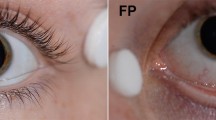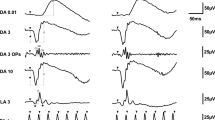Abstract
Purpose
To evaluate and compare the wave amplitude of multifocal electroretinogram (mfERG) measurements and discomfort from Dawson–Trick–Litzkow (DTL) electrode located on the cornea (cDTL) and on the conjunctival fornix (fDTL) and ERG-jet contact lens electrode (CL).
Methods
Thirty-six patients and 18 healthy volunteers were evaluated with three different methods (cDTL, fDTL and CL). Wave amplitude, number of artifacts, number of electrode dislocations and level of discomfort obtained with each electrode were compared. These variables were also compared between patients and healthy volunteers (control group). Comparisons between wave amplitudes were made using intraclass correlation coefficient (ICC).
Results
Responses by the three tested electrode were better correlated (ICC) in patient (0.616–0.756) than in control groups (0.342–0.679). CL provided the highest wave amplitude in both groups (p < 0.005), but it was associated with higher discomfort (p < 0.001) and the highest rate of dislocations (72 and 100 % in control and patients, respectively). Looking at the differences obtained by each electrode between both groups, CL seems to be able to differentiate patient from control in the ring 1 of the mfERG. By contrast, fDTL gave the lowest wave amplitude in both groups, but it had the advantage to, apparently, discriminate between patients and control group in rings 1 and 2. cDTL produced more artifacts than the other electrodes in both groups (p < 0.001).
Conclusions
Although wave amplitude measurements with different electrodes were correlated, they cannot be directly compared, so it is mandatory to create an appropriate normative database with each electrode. Despite providing the lowest amplitudes, fDTL seems to offer the best features to perform mfERG regarding discomfort, number of artifacts and diagnostic capability.


Similar content being viewed by others
References
Sutter E, Tran D (1992) The field topography of ERG components in man. Vision Res 32(3):433–446
Heckenlively JR, Arden GB, Nusinowitz S, Holder GE, Bach M (2006) Principles and practice of clinical electrophysiology of vision, 2nd edn. MIT Press, London
Hood DC (2000) Assesing retinal function with the multifocal technique. Prog Ret Eye Res 19:207–246
Beeler P, Barthelmes D, Sutter FK, Helbig H, Fleischhauer JC (2007) Comparison of performance and patient satisfaction of two types of ERG electrodes. Klin Mobl Augenheilkd 224(4):265–268
Kuze M, Uji Y (2000) Comparison between Dawtson, Trick, and Litzkow electrode and contact lens electrodes used in clinical electroretinography. Jpn J Ophthalmol 44(4):374–380
Yin H, Pardue MT (2004) Performance of the DTL electrode compared to the Jet contact lens electrode in clinical testing. Doc Ophthalmol 108:77–86
Mohidin N, Yap MK, Jacobs RJ (1997) The repeatability and variability of the multifocal electroretinogram for four different electrode types. Ophthalmic Physiol Opt 17(6):530–535
Thimonier C, Daubas P, Bourdon L, Deral-Stephant V, Menu JP, Vignal R, Roux C (2008) ERG multifocal avec électrodes ERG-jet et Gold Foil chez le sujet normal: comparaison et reproducibilité. J Fr Ophthalmol 31(6):585–590
Hood DC, Bach M, Brigell MG, Keating D, Kondo M, Lyons J, Marmor M, McCulloch DL, Palmowski-Wolfe A (2012) ISCEV Standard for clinical multifocal electroretinography (mfERG) (2011 edition). Doc Ophthalmol 124(1):1–13
Fleiss JL (1986) The design and analysis of clinical experiments. Wiley Classics Library, New York
Otto T, Bach M (1997) Reproducibility of the pattern electroretinogram. Ophthalmologe 94(3):217–221
Honda Y (1977) Some characteristics of the c-wave of ERGs recorded by a pair of electrodes on the cornea and sclera. Albrecht v Graefes Arch Klin Exp Ophth 202:19–26
McAllan A, Sinn J, Aylward GW (1989) The effect of gold foil electrode position on the electroretinogram in human subjects. Vis Res 29(9):1085–1087
Feng Y, Simpson TL (2003) Nociceptive sensation and sensitivity evoked from human cornea and conjunctiva stimulated by CO2. Invest Ophthalmol Vis Sci 44(2):529–532
Yoshii M, Yanashima K, Suzuki S, Okisaka S (2000) Artifact removal procedure distorts multifocal electroretinogram. Jpn J Ophthalmol 44(4):419–423
Zaragoza P (2011) Aplicaciones clínicas de la electrofisiología ocular. Sociedad Española de Oftalmología, Madrid
Chan HH, Ng YF, Chu PH (2011) Applications of the multifocal electroretinogram in the detection of glaucoma. Clin Exp Optom 94(3):247–258
Curcio CA, Sloan KR, Kalina RE, Hendrickson AE (1990) Human photoreceptor topography. J Comp Neurol 300(1):5–25
Keating D, Parks S, Evans A (2000) Technical aspects of multifocal ERG recording. Doc Ophthalmol 100:77–98
Funding
No funding was received for this research.
Author information
Authors and Affiliations
Corresponding author
Ethics declarations
Conflict of interest
All authors certify that they have no affiliations with or involvement in any organisation or entity with any financial interest (such as honoraria; educational grants; participation in speaker’s bureaus; membership, employment, consultancies, stock ownership, or other equity interest; and expert testimony or patent-licensing arrangements), or non-financial interest (such as personal or professional relationships, affiliations, knowledge or beliefs) in the subject matter or materials discussed in this manuscript.
Ethical approval
All procedures performed in studies involving human participants were in accordance with the ethical standards of the institutional and/or national research committee and with the 1964 Helsinki Declaration and its later amendments or comparable ethical standards.
Informed consent
Informed consent was obtained from all individual participants included in the study.
Rights and permissions
About this article
Cite this article
García-García, Á., Muñoz-Negrete, F.J. & Rebolleda, G. Variability of the multifocal electroretinogram based on the type and position of the electrode. Doc Ophthalmol 133, 99–108 (2016). https://doi.org/10.1007/s10633-016-9560-z
Received:
Accepted:
Published:
Issue Date:
DOI: https://doi.org/10.1007/s10633-016-9560-z




